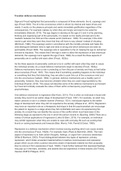Essay
Critically discuss the value of one of the following theories for contemporary psychology/psychotherapy: Freudian Defence Mechanisms
- Module
- Approaches in Psychology
- Institution
- AQA
- id, superego and ego - defence mechanisms (role) - regression - repression - displacement - issues with Freud's defence mechanisms - critical analysis of Freud's defence mechanisms
[Show more]



